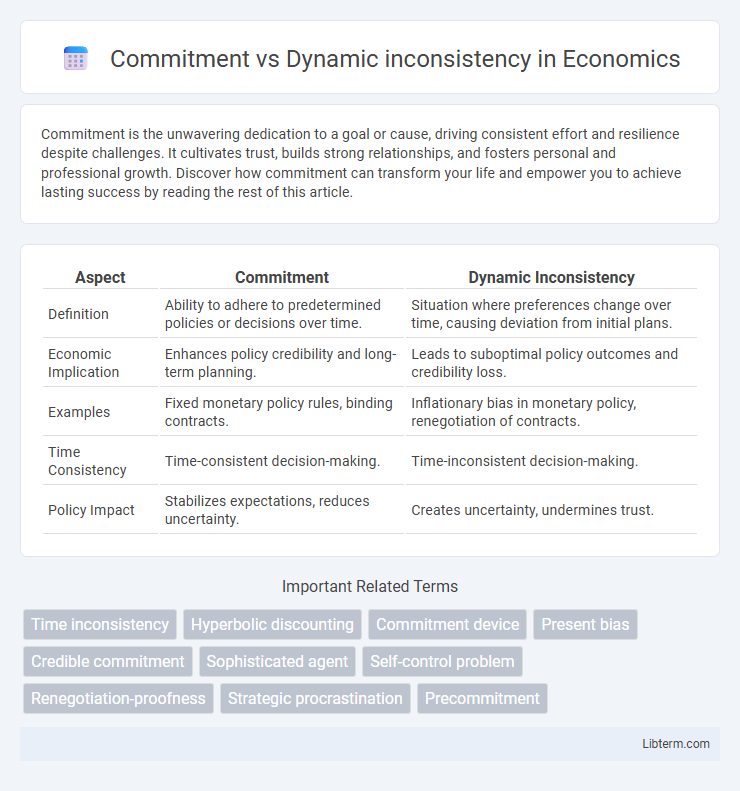Commitment is the unwavering dedication to a goal or cause, driving consistent effort and resilience despite challenges. It cultivates trust, builds strong relationships, and fosters personal and professional growth. Discover how commitment can transform your life and empower you to achieve lasting success by reading the rest of this article.
Table of Comparison
| Aspect | Commitment | Dynamic Inconsistency |
|---|---|---|
| Definition | Ability to adhere to predetermined policies or decisions over time. | Situation where preferences change over time, causing deviation from initial plans. |
| Economic Implication | Enhances policy credibility and long-term planning. | Leads to suboptimal policy outcomes and credibility loss. |
| Examples | Fixed monetary policy rules, binding contracts. | Inflationary bias in monetary policy, renegotiation of contracts. |
| Time Consistency | Time-consistent decision-making. | Time-inconsistent decision-making. |
| Policy Impact | Stabilizes expectations, reduces uncertainty. | Creates uncertainty, undermines trust. |
Understanding Commitment and Dynamic Inconsistency
Commitment refers to a decision-maker's ability to bind themselves to a course of action, ensuring consistency over time despite changing incentives or preferences. Dynamic inconsistency occurs when preferences evolve, leading individuals or institutions to deviate from previously planned strategies, undermining commitment devices. Understanding these concepts is crucial for designing policies or contracts that align long-term goals with short-term behaviors, minimizing time-inconsistent choices.
Defining Commitment in Decision-Making
Commitment in decision-making refers to the binding promise or adherence to a chosen course of action, ensuring consistent behavior over time despite changing preferences or circumstances. It serves as a strategic tool to align future actions with current goals, preventing shifts caused by dynamic inconsistency, where preferences evolve and lead to contradictory choices. Effective commitment mechanisms enhance credibility and trustworthiness by reducing time-inconsistency problems in economic, behavioral, and strategic decision contexts.
What Is Dynamic Inconsistency?
Dynamic inconsistency occurs when a decision-maker's preferences change over time, causing plans made in the past to be suboptimal or undesirable in the future. This phenomenon often arises due to time-inconsistent preferences, such as hyperbolic discounting, where immediate rewards are disproportionately favored over long-term benefits. Understanding dynamic inconsistency is crucial for designing commitment mechanisms that align present and future incentives, thereby improving decision outcomes and reducing procrastination or preference reversals.
Psychological Roots of Dynamic Inconsistency
Dynamic inconsistency arises from the psychological tension between immediate desires and long-term goals, driven by present-biased preferences and impulsivity. Hyperbolic discounting explains why individuals disproportionately favor smaller, immediate rewards over larger, future benefits, undermining commitment strategies. This cognitive bias reflects the struggle to maintain self-control, as evolving preferences conflict with previously set intentions.
Real-Life Examples of Dynamic Inconsistency
Dynamic inconsistency occurs when individuals' preferences change over time, leading to decisions they later regret, such as procrastinating on savings or unhealthy eating despite initial commitments. For example, a person may commit to a strict exercise routine but later choose immediate comfort over long-term fitness goals, demonstrating a shift in preference. Another real-life case is smokers intending to quit but repeatedly delaying cessation due to momentary cravings, highlighting how dynamic inconsistency undermines consistent decision-making.
The Role of Commitment Devices
Commitment devices are strategic tools designed to align future actions with present intentions, effectively mitigating dynamic inconsistency in decision-making. By creating binding constraints or penalties, they prevent individuals from succumbing to short-term temptations that conflict with long-term goals. These mechanisms enhance self-control, ensuring consistency in preferences over time and improving outcomes in behavioral economics and personal finance.
Overcoming Dynamic Inconsistency Through Commitment
Overcoming dynamic inconsistency relies heavily on commitment devices, which bind future actions to present decisions, reducing the temptation to deviate from planned behaviors. These devices include contracts, pre-commitment mechanisms, and behavioral nudges that enforce consistency over time, aligning long-term goals with short-term incentives. Empirical studies in behavioral economics highlight the effectiveness of commitment strategies in promoting patience and adherence to optimal intertemporal choices.
Commitment Strategies in Everyday Life
Commitment strategies in everyday life involve setting clear, binding goals to avoid the pitfalls of dynamic inconsistency, where preferences change over time, undermining long-term plans. Techniques such as automatic savings plans, public commitments, and pre-commitment devices help individuals stick to their intended decisions despite shifting incentives. These strategies leverage behavioral insights to align present actions with future goals, enhancing self-control and goal attainment.
Impacts of Dynamic Inconsistency on Long-Term Goals
Dynamic inconsistency undermines long-term goals by causing individuals or organizations to deviate from initially optimal plans due to changing preferences or incentives over time. This behavior leads to suboptimal decision-making, reduced credibility in commitments, and increased difficulty in achieving sustained outcomes such as financial savings, health improvements, or strategic business objectives. The erosion of commitment mechanisms from dynamic inconsistency results in higher risks of procrastination, policy reversals, and failure to deliver consistent growth or performance.
Practical Tips to Enhance Commitment and Reduce Inconsistency
Enhancing commitment and reducing dynamic inconsistency requires setting clear, measurable goals and establishing accountability through regular progress tracking or social commitments. Utilizing commitment devices like automatic savings plans or pre-commitment contracts helps align future actions with current intentions, minimizing impulsive deviations. Consistently reviewing and adjusting plans based on feedback ensures sustained motivation and reduces the likelihood of time-inconsistent decisions.
Commitment Infographic

 libterm.com
libterm.com